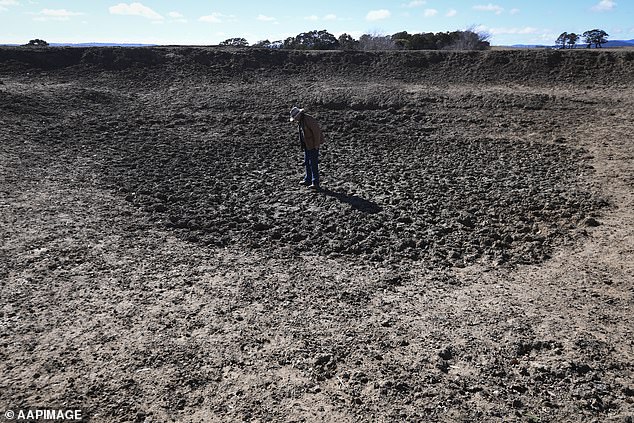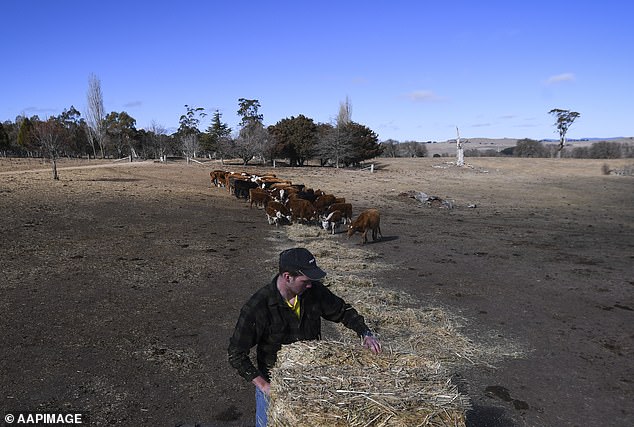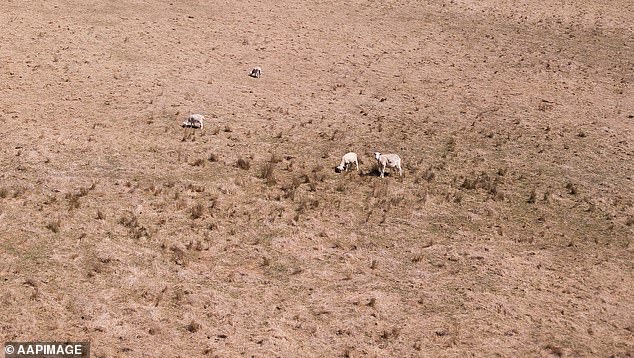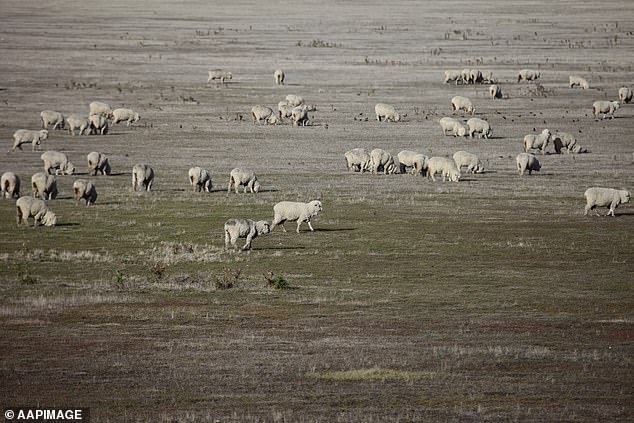The first National Climate Risk Assessment report suggests a dystopian future for Australia if it fails to properly prepare for a wide range of threats.
The report released on Tuesday, produced by the Australian government’s Department of Climate Change, is a first attempt to assess the scale of climate risks Australia could face as the planet warms.
In total, it identifies 56 nationally significant risks, but boils them down to 11 very dangerous ones that go to the heart of human survival.
They include access to food and water and Australia’s ability to respond to more frequent and severe disasters.

Australia’s first climate change assessment has issued a dire warning for the nation’s future if the country does not take action to address looming threats as the planet warms (pictured a farmer inspects a dry dam)
They include how warming will affect human health, and the state of land and sea ecosystems on which everything depends.
They also cover risks to Australia’s economy, including the supply of essential goods and services.
In terms of food security, it warns that the changing climate could have a major impact on Australia’s ability to produce food, which in turn poses risks to human health and nutrition.
On the water, it warns that climate change is likely to lead to prolonged droughts, increases in extreme heat, more variable rainfall and more severe flooding.
“These impacts will result in increased variability and possibly reduced quality, quantity, availability and accessibility of water supplies,” it says, while increasing competition between society and industry.
On the economy, it says that climate-related volatility, such as financial shocks, crises and tipping points, are difficult to quantify, ‘but can create macroeconomic shocks that are felt across all systems’.
Supply chain disruptions from increasingly frequent and severe disasters can seriously disrupt life in Australia and affect access to basic goods and services, including food, fuel and medicine.
And the list of human health risks is long, from direct impacts from disasters to climate-related hazards such as extreme heat, air pollution from wildfires and growing disease risks.
Environmental risks include obvious things like habitat loss from disasters, but also impacts on air, water and soil quality.


The assessment included warnings about the future impact of climate change on human health and the state of the soil (pictured a farmer preparing hay to feed his cattle)


Risks from climate change also include prolonged drought and an increase in extreme heat (pictured on a farmer’s property)
The assessment warns that if climate-related disasters occur regularly enough, there could be permanent changes in the way landscapes function.
Assistant Minister for Climate Change Jenny McAllister says effective climate adaptation will be essential if Australia is to cope with the impacts of climate change, which scientists say are already locked in.
‘Acting at risk is not an admission of defeat. It is an opportunity to protect and build the things we value, she said.
The minister said some changes to help future-proof Australia would be routine, others would be harder to manage and some could be impossible to avoid.
“Good government can act to mitigate climate change while planning for the changes that are already locked in. That doesn’t mean giving up on reducing emissions.”
The new assessment will inform phase two work – a deep dive into Australia’s 11 priority risks.
That report is due by the end of this year and will inform a new national adaptation plan that the government promised last year.
“The evidence from this report tells us that the risks are not just bushfires, more severe storms and sea level rise, they are broader than many imagine,” Senator McAllister said.
‘Investing in adaptation work now gives us the best chance to limit the impact of climate change on our societies, our economy and our natural environment.’


The assessment warns that if climate-related disasters occur regularly, there could be permanent changes in the way landscapes function (image shows sheep grazing on a patch of land)
